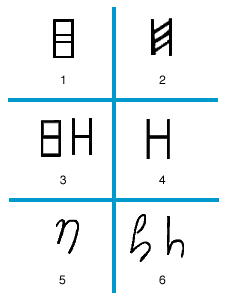H&m
Bạn đang xem: H&m
Corrections? Updates? Omissions? Let us know if you have suggestions khổng lồ improve this article (requires login).
Feedback TypeSelect a type (Required)Factual CorrectionSpelling/Grammar CorrectionLink CorrectionAdditional InformationOther
Our editors will đánh giá what you’ve submitted and determine whether to revise the article.
Xem thêm: Phim Bác Sĩ Xứ Lạ Tập 1 Full (2014), Bác Sĩ Xứ Lạ
Join lrocrevn.com"s Publishing Partner Program and our community of experts khổng lồ gain a global audience for your work!
h, eighth letter of the alphabet. It corresponds lớn Semitic cheth & Greek eta (Η). It may derive from an early symbol for fence. In the early Greek alphabets a khung with three horizontal bars và the simpler size H were both widely distributed. In Etruscan the prevailing form was similar to the early Greek form, và the same or a similar khung occurs in very early Latin inscriptions, but the form H came into general use in Latin, either from the Chalcidic Greek alphabet of Cumae or from some other source. The modern majuscule H is derived directly from the Latin. The cursive Latin form resembled a stylized version of the modern minuscule h, as did the uncial form. Both of these forms result from writing the letter without taking the pen from the paper, the right-hand vertical bar being thus foreshortened và the horizontal stroke rounded. From these came the Carolingian size as well as the modern minuscule h.
In the alphabets used to write the East Ionic dialect of Greek the letter became superfluous as a result of the disappearance of the aspirate which it represented in that dialect. It was accordingly put khổng lồ a new use khổng lồ indicate the xuất hiện long e which had arisen through alteration of the primitive Greek long a. In a few inscriptions from Thera, Naxos, and several other localities the letter was used with syllabic value; that is, it included he, thus showing its old consonantal and its new vocalic value at the same time. Eventually, as a result of the spread of the Ionic alphabet, its use for the long vowel e or η became general throughout Greece, while its consonantal value as the aspirate h passed from the western Greek alphabets into the Etruscan alphabets and then into the Latin and other alphabets of ancient Italy. In the Romance languages the sound has largely disappeared, but the letter is still extensively used, partly with only etymological value, (e.g., French homme), partly with fancied etymological value (e.g., French haut from Latin altus, with h through the influence of hoh, the Old High German word of the same meaning), partly with special orthographical functions. For example, in Italian h is used in combination with c or g to lớn indicate the hard sound before a front vowel (e.g., chi, ghetto).
In English the initial h is pronounced in words of Germanic origin (e.g., hunt, hook); in some words of Romance origin, the h remains unpronounced (e.g., heir, honour), but in others it has been restored (e.g., humble, humour). The initial h often disappears in unaccented syllables (e.g., “What did he say?”). In chemistry H is the symbol for the element hydrogen.











